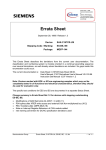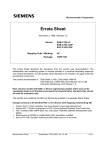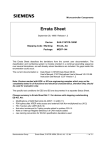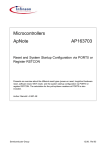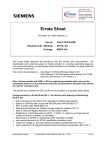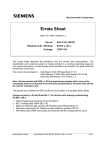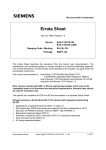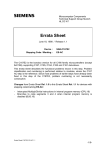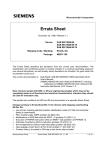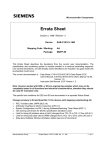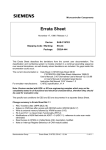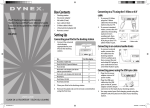Download Errata Sheet
Transcript
Microcontroller Components Errata Sheet January 11, 1999 / Release 1.0 Device: Stepping Code / Marking: Package: C164CI-8R EES-AB (C-MQFP-80), ES-AB, AB MQFP-80 This Errata Sheet describes the deviations from the current user documentation. The classification and numbering system is module oriented in a continual ascending sequence over several derivatives, as well already solved deviations are included. So gaps inside this enumeration could occur. The current documentation is: Data Sheet: C164CI Data Sheet 02.98 (until separate or updated Data Sheet is available) User’s Manual: C164CI User’s Manual V1.1 1998-08 Target Specification C164xy-8R V1.0 1998-07 (until updated User’s Manual is available) Instruction Set Manual 12.97 Version 1.2 Note: Devices marked with EES- or ES are engineering samples which may not be completely tested in all functional and electrical characteristics, therefore they should be used for evaluation only. The specific test conditions for EES and ES are documented in a separate Status Sheet. Semiconductor Group Errata Sheet, C164CI-8R, EES/ES-AB, AB, 1.0, Es - 1 of 8 – Functional Problems: PWRDN.1: Execution of PWRDN Instruction while pin NMI# = high When instruction PWRDN is executed while pin NMI# is at a high level, power down mode should not be entered, and the PWRDN instruction should be ignored. However, under the conditions described below, the PWRDN instruction may not be ignored, and no further instructions are fetched from external memory, i.e. the CPU is in a quasi-idle state. This problem will only occur in the following situations: a) the instructions following the PWRDN instruction are located in external memory, and a multiplexed bus configuration with memory tristate waitstate (bit MTTCx = 0) is used, or b) the instruction preceeding the PWRDN instruction writes to external memory or an XPeripheral (CAN), and the instructions following the PWRDN instruction are located in external memory. In this case, the problem will occur for any bus configuration. Note: the on-chip peripherals are still working correctly, in particular the Watchdog Timer will reset the device upon an overflow. Interrupts and PEC transfers, however, can not be processed. In case NMI# is asserted low while the device is in this quasi-idle state, power down mode is entered. Workaround: Ensure that no instruction which writes to external memory or an XPeripheral preceeds the PWRDN instruction, otherwise insert e.g. a NOP instruction in front of PWRDN. When a muliplexed bus with memory tristate waitstate is used, the PWRDN instruction should be executed out of internal RAM. Semiconductor Group Errata Sheet, C164CI-8R, EES/ES-AB, AB, 1.0, Es - 2 of 8 – BUS.18: PEC Transfers after JMPR instruction Problems may occur when a PEC transfer immediately follows a taken JMPR instruction when the following sequence of 4 conditions is met (labels refer to following examples): 1. in an instruction sequence which represents a loop, a jump instruction (Label_B) which is capable of loading the jump cache (JMPR, JMPA, JB/JNB/JBC/JNBS) is taken 2. the target of this jump instruction directly is a JMPR instruction (Label_C) which is also taken and whose target is at address A (Label_A) 3. a PEC transfer occurs immediately after this JMPR instruction (Label_C) 4. in the following program flow, the JMPR instruction (Label_C) is taken a second time, and no other JMPR, JMPA, JB/JNB/JBC/JNBS or instruction which has branched to a different code segment (JMPS/CALLS) or interrupt has been processed in the meantime (i.e. the condition for a jump cache hit for the JMPR instruction (Label_C) is true) In this case, when the JMPR instruction (Label_C) is taken for the second time (as described in condition 4 above), and the 2 words stored in the jump cache (word address A and A+2) have been processed, the word at address A+2 is erroneously fetched and executed instead of the word at address A+4. Note: the problem does not occur when - the jump instruction (Label_C) is a JMPA instruction - the program sequence is executed from internal Flash Example1: Label_A: instruction x ; Begin of Loop instruction x+1 ..... Label_B: JMP Label_C ; JMP may be any of the following jump instructions: JMPR cc_zz, JMPA cc_zz, JB/JNB/JBC/JNBS ; jump must be taken in loop iteration n ; jump must not be taken in loop iteration n+1 ..... Label_C: JMPR cc_xx, Label_A ; End of Loop ; instruction must be JMPR (single word instruction) ; jump must be taken in loop iteration n and n+1 ; PEC transfer must occur in loop iteration n Example2: Label_A: instruction x ; Begin of Loop1 instruction x+1 ..... Label_C: JMPR cc_xx, Label_A ; End of Loop1, Begin of Loop2 ; instruction must be JMPR (single word instruction) ; jump not taken in loop iteration n-1, i.e. Loop2 is entered ; jump must be taken in loop iteration n and n+1 ; PEC transfer must occur in loop iteration n ..... Label_B: JMP Label_C ; End of Loop2 ; JMP may be any of the following jump instructions: JMPR cc_zz, JMPA cc_zz, JB/JNB/JBC/JNBS ; jump taken in loop iteration n-1 A code sequence with the basic structure of Example1 was generated e.g. by a compiler for comparison of double words (long variables). Semiconductor Group Errata Sheet, C164CI-8R, EES/ES-AB, AB, 1.0, Es - 3 of 8 – Workarounds: 1. use a JMPA instruction instead of a JMPR instruction when this instruction can be the direct target of a preceding JMPR, JMPA, JB/JNB/JBC/JNBS instruction, or 2. insert another instruction (e.g. NOP) as branch target when a JMPR instruction would be the direct target of a preceding JMPR, JMPA, JB/JNB/JBC/JNBS instruction, or 3. change the loop structure such that instead of jumping from Label_B to Label_C and then to Label_A, the jump from Label_B directly goes to Label_A. Notes on compilers: In the Hightec compiler beginning with version Gcc 2.7.2.1 for SAB C16x – V3.1 Rel. 1.1, patchlevel 5, a switch –m bus18 is implemented as workaround for this problem. In addition, optimization has to be set at least to level 1 with –u1. The Keil C compiler and run time libraries do not generate or use instruction sequences where a JMPR instruction can be the target of another jump instruction, i.e. the conditions for this problem do not occur. In the TASKING C166 Software Development Tools, the code sequence related to problem BUS.18 can be generated in Assembly. The problem can also be reproduced in C-language by using a particular sequence of GOTOs. With V6.0r3, TASKING tested all the Libraries, C-startup code and the extensive set of internal testsuite sources and the BUS.18 related code sequence appeared to be NOT GENERATED. To prevent introduction of this erroneous code sequence, the TASKING Assembler V6.0r3 has been extended with the CHECKBUS18 control which generates a WARNING in the case the described code sequence appears. When called from within EDE, the Assembler control CHECKBUS18 is automatically 'activated'. Semiconductor Group Errata Sheet, C164CI-8R, EES/ES-AB, AB, 1.0, Es - 4 of 8 – ADC.11: Modifications of ADM field while bit ADST = 0 The A/D converter may unintentionally start one auto scan single conversion sequence when the following sequence of conditions is true: (1) the A/D converter has finished a fixed channel single conversion of an analog channel n > 0 (i.e. contents of ADCON.ADCH = n during this conversion) (2) the A/D converter is idle (i.e. ADBSY = 0) (3) then the conversion mode in the ADC Mode Selection field ADM is changed to Auto Scan Single (ADM = 10b) or Continuous (ADM = 11b) mode without setting bit ADST = 1 with the same instruction Under these conditions, the A/D converter will unintentionally start one auto scan single conversion sequence, beginning with channel n-1, down to channel number 0. When no interrupt or PEC is servicing the A/D Conversion Complete Interrupt, interrupt request flag ADCIR will be set, and for n > 1 also the A/D Overrun Error interrupt request flag will be set, unless the wait for ADDAT read mode had been selected. When ADCON.ADWR = 1 (wait for ADDAT read), the converter will wait after 2 conversions until ADDAT is read. In case the channel number ADCH has been changed before or with the same instruction which selected the auto scan mode, this channel number has no effect on the unintended auto scan sequence (i.e. it is not used in this auto scan sequence). Note: When a conversion is already in progress, and then the configuration in register ADCON is changed, - the new conversion mode in ADM is evaluated after the current conversion - the new channel number in ADCH and new status of bit ADST are evaluated after the current conversion when a conversion in fixed channel conversion mode is in progress, and after the current conversion sequence (i.e. after conversion of channel 0) when a conversion in an auto scan mode is in progress. In this case, it is a specified operational behaviour that channels n-1 .. 0 are converted when ADM is changed to an auto scan mode while a fixed channel conversion of channel n is in progress (see e.g. C164CI User’s Manual, V1.0, p.18-4) Workaround: When an auto scan conversion is to be performed, always start the A/D converter with the same instruction which sets the configuration in register ADCON. Semiconductor Group Errata Sheet, C164CI-8R, EES/ES-AB, AB, 1.0, Es - 5 of 8 – X9: Read Access to XPERs in Visible Mode The data of a read access to an XBUS-Peripheral (CAN) in Visible Mode (SYSCON.1 = 1) is not driven to the external bus. PORT0 is tristated during such read accesses. Note that in Visible Mode PORT1 will drive the address for an access to an XBUS-Peripheral, even when only a multiplexed external bus is enabled. Note on Interrupt Register behaviour of the CAN module Due to the internal state machine of the CAN module, a specific delay has to be considered between resetting INTPND and reading the updated value of INTID. See Application Note AP2924 " Interrupt Register behaviour of the CAN module in Siemens 16-bit Microcontrollers" on http://www.siemens.de/semiconductor/products/ics/34/pdf/ap292401.pdf RTC.4: Undefined Results after write to T14 A write operation to T14 leads to undefined results depending on contents of T14REL. Workaround: st nd Load T14REL (1 ) and T14 (2 ) with the desired value. POWER.7: Wake Up from Sleep while RTC switched off After wake up from Sleep Mode the CPU is immediately started unless waiting for correct clock function. During the first phase of the oscillator startup time the input clock can be disturbed and in worst case fCPU exceeds the specified value – resulting in CPU malfunctions. Workaround: Leave RTC on while in Sleep Mode (SYSCON1.1-0 = 01b) Semiconductor Group Errata Sheet, C164CI-8R, EES/ES-AB, AB, 1.0, Es - 6 of 8 – Deviations from Electrical- and Timing Specification: The following table lists the deviations of the DC/AC characteristics from the specification in the C164CI Data Sheet 02.98 • DC.VDD.2 2) Problem VDD = 4.4 .. 5.5 V instead of 4.25 .. 5.5 V (for CAN module only) Parameter Symbol Limit Values short name 1) DC.HYS.1 1) DC.VILS.1 DC.IPDR.2 min. Input Hysteresis (Special Threshold) HYS 300 1) Unit Test max. - Condition mV - V - instead of 400 Input low voltage (Special VILS Threshold) - 0.5 Power-down mode supply IPDR current with RTC running - 1.7 1) instead of 2.0 200 + 25 x fOSC µA instead of 100 + 25 x fOSC VDD = 5.5V fOSC in [MHz] 1) For VDD > 4.4V and fCPU < 16 MHz the specified value is guaranteed by design. 2) For fCPU < 8 MHz the specified VDD value for CAN module is guaranteed by design. Semiconductor Group Errata Sheet, C164CI-8R, EES/ES-AB, AB, 1.0, Es - 7 of 8 – History List (since device step ES-AA) Functional Problems Functional Problem Short Description PWRDN.1 Execution of PWRDN Instruction while pin NMI# = high BUS.18 PEC transfers after JMPR ADC.11 Modifications of ADM field while bit ADST = 0 X9 Read Access to XPERs in Visible Mode RTC.4 Undefined Results after write to T14 POWER.7 Wake Up from Sleep while RTC switched off Fixed in step AC/DC Deviations AC/DC Deviation Short Description DC.VDD.2 Device Supply Voltage VDD min. 4.4 V for CAN Module only DC.HYS.1 Input Hysteresis (Special Threshold) 300 mV DC.VILS.1 Input low voltage (Special Threshold) 1.7 V DC.IPDR.2 Power-down mode supply current with RTC running (200 + 25 x fOSC[MHz] µA) Fixed in step Application Support Group, Munich Semiconductor Group Errata Sheet, C164CI-8R, EES/ES-AB, AB, 1.0, Es - 8 of 8 –








